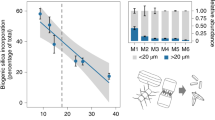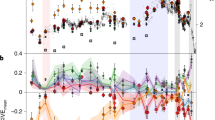Abstract
The origins of sapropels (sedimentary layers rich in organic carbon) are unclear, yet they may be a key to understanding the influence of climate on ocean eutrophication, the mechanisms of sustaining biological production in stratified waters and the genesis of petroleum source rocks1,2,3. Recent microfossil studies of foraminifera1 and calcareous nannofossils2 have focused attention on a deep chlorophyll maximum as a locus for the high production inferred3 for sapropel formation, but have not identified the agent responsible. Here we report the results of a high-resolution, electron-microscope-based study of a late Quaternary laminated sapropel in which the annual flux cycle has been preserved. We find that much of the production was by diatoms, both mat-forming and other colonial forms, adapted to exploit a deep nutrient supply trapped below surface waters in a stratified water column. Reconstructed organic-carbon and opal fluxes to the sediments are comparable to those at high-productivity sites in today's oceans, and calculations based on diatom Si/C ratios suggest that the high organic-carbon content of sapropels may be entirely accounted for by sedimenting diatoms. We propose that this style of production may have been common in ancient Palaeogene and Cretaceous seas, environments for which conventional appeals to upwelling-driven production to account for the occurrence of diatomites, and some organic-carbon-rich sediments, have never seemed wholly appropriate.
This is a preview of subscription content, access via your institution
Access options
Subscribe to this journal
Receive 51 print issues and online access
$199.00 per year
only $3.90 per issue
Buy this article
- Purchase on Springer Link
- Instant access to full article PDF
Prices may be subject to local taxes which are calculated during checkout



Similar content being viewed by others
References
Rohling, E. J. Review and new aspects concerning formation of the Mediterranean sapropels. Mar. Geol. 122, 1–28 (1994).
Castradori, D. Calcareous nannofossils and the origin of eastern Mediterranean sapropels. Paleoceanography 8, 459–471 (1993).
Calvert, S. E., Nielsen, B. & Fontugne, M. R. Evidence from nitrogen isotope ratios for enhanced productivity during formation of eastern Mediterranean sapropels. Nature 359, 223–225 (1992).
De Lange, G. J.et al. Composition of anoxic hypersaline brines in the Tyro and Bannock Basins, eastern Mediterranean. Mar. Chem. 31, 63–88 (1990).
Villareal, T. A., Altabet, M. A. & Culver-Rymsza, K. Nitrogen transport by vertically migrating diatom mats in the North Pacific Ocean. Nature 363, 709–712 (1993).
Yoder, J. A., Ackleson, S., Barber, R. T., Flamant, P. & Balch, W. A. Aline in the Sea. Nature 371, 689–692 (1994).
Kemp, A. E. S. & Baldauf, J. G. Vast Neogene laminated diatom mat deposits from the eastern equatorial Pacific Ocean. Nature 362, 141–143 (1993).
Pearce, R. B.et al. Alamina-scale, SEM-based study of a diatom-ooze sapropel from the Eastern Mediterranean (ODP Leg 160). Proc. ODP Sci. Res. 160, 333–348 (1998).
Kemp, A. E. S., Pearce, R. B., Pike, J. & Marshall, J. E. A. Microfabric and microcompositional studies of Pliocene and Quaternary sapropels from the eastern Mediterranean. Proc. ODP Sci. Res. 160, 349–364 (1998).
Schrader, H. J. & Matherne, A. Sapropel formation in the eastern Mediterranean sea: evidence from preserved opal assemblages. Micropaleontology 27, 191–203 (1981).
Pagou, K. & Gotsis-Skretas, O. Acomparative study of phytoplankton in S. Aegean, Levantine and Ionian Seas during March–April. Thalassographica 13, 13–18 (1990).
Ignatiades, L., Georgopoulos, D. & Karydis, M. Description of the phytoplanktonic community of the oligotrophic waters of the SE Aegean Sea (Mediterranean). Mar. Ecol. 16, 13–26 (1995).
Alldredge, A. L. & Gotschalk, C. C. Direct observations of the mass flocculation of diatom blooms: characteristics, settling velocities and formation of diatom aggregates. Deep-Sea Res. 36, 159–171 (1989).
Grimm, K. A., Lange, C. B. & Gill, A. S. Self-sedimentation of phytoplankton blooms in the geologic record. Sedim. Geol. 100, 151–161 (1997).
Guillard, R. R. L. & Kilham, P. in The Biology of Diatoms (ed. Werner, D.) 372–469 (Botanical Monogr. 13, Univ. California Press, Berkeley, (1977)).
Villareal, T. A. Nitrogen-fixation by the cyanobacterial symbiont of the diatom genus Hemiaulus. Mar. Ecol. Prog. Ser. 76, 201–204 (1991).
Goldman, J. C. Potential role of large oceanic diatoms in new primary production. Deep-Sea Res. I 40, 159–168 (1993).
Smith, C. R.et al. Phytodetritus at the abyssal seafloor across 10° of latitude in the central equatorial Pacific. Deep-Sea Res. II 43, 1309–1338 (1996).
Sancetta, C., Villareal, T. & Falkowski, P. Massive fluxes of Rhizosolenid diatoms: a common occurrence? Limnol. Oceanogr. 36, 1452–1457 (1991).
Thunell, R., Pride, C., Tappa, E. & Muller-Karger, F. Varve formation in the Gulf of California: Insights from time series sediment trap sampling and remote sensing. Quat. Sci. Rev. 12, 451–464 (1993).
Sancetta, C. Diatoms in the Gulf of California: Seasonal flux patterns and the sediment record for the last 15, 000 years. Paleoceanography 10, 67–84 (1995).
Pike, J. & Kemp, A. E. S. Early Holocene decadal-scale ocean variability recorded in Gulf of California laminated sediments. Paleoceanography 12, 227–238 (1997).
Richardson, T. L., Ciotti, A. M., Cullen, J. J. & Villareal, T. A. Physiological and optical properties of Rhizosolenia formosa (Bacillariophyceae) in the context of open-ocean vertical migration. J. Phycol. 32, 741–757 (1996).
Sancetta, C. Mediterranean sapropels: Seasonal stratification yields high production and carbon flux. Paleoceanography 9, 195–196 (1994).
Rossignol-Strick, M., Nesteroff, V., Olive, P. & Vergnaud-Grazzini, C. After the deluge; Mediterranean stagnation and sapropel formation. Nature 295, 105–110 (1982).
Van Os, B. J. H., Lourens, L. J., Hilgen, F. J., De Lange, G. J. & Beaufort, L. The formation of Pliocene sapropels and carbonate cycles in the Mediterranean: diagenesis, dilution and productivity. Paleoceanography 9, 601–617 (1994).
Tang, C. M. & Stott, L. D. Seasonal salinity changes during Mediterranean sapropel deposition 9, 000 years B.P.: evidence from isotopic analyses of individual planktonic forminifera. Palaeoceanography 8, 473–493 (1993).
Brzezinski, M. A. The Si:C:N ratio of marine diatoms: interspecific variability and the effect of some environmental variables. J. Phycol. 21, 347–357 (1985).
Arthur, M. A.et al. Varve calibrated records of carbonate and organic carbon accumulation over the last 2000 years in the Black Sea. Glob. Biogeochem. Cycles 8, 195–217 (1994).
Dell'Agnese, D. J. & Clark, D. L. Siliceous microfossils from the warm late Cretaceous and early Cenozoic Arctic Ocean. J. Paleontol. 68, 31–47 (1994).
Jacobs, D. K. & Sahagian, D. L. in Sequence Stratigraphy and Depositional Response to Eustatic, Tectonic and Climatic Forcing (ed. Haq, B. U.) 329–366 (Kluwer, Dordrecht, (1995)).
Mortlock, R. A. & Froelich, P. N. Asimple method for the rapid determination of biogenic opal in marine sediments. Deep-Sea Res. 36, 1415–1426 (1989).
Acknowledgements
We acknowledge funding from the NERC ODP research grant and research fellowship programme.
Author information
Authors and Affiliations
Corresponding author
Supplementary information
Rights and permissions
About this article
Cite this article
Kemp, A., Pearce, R., Koizumi, I. et al. The role of mat-forming diatoms in the formation of Mediterranean sapropels. Nature 398, 57–61 (1999). https://doi.org/10.1038/18001
Received:
Accepted:
Issue Date:
DOI: https://doi.org/10.1038/18001
Comments
By submitting a comment you agree to abide by our Terms and Community Guidelines. If you find something abusive or that does not comply with our terms or guidelines please flag it as inappropriate.



